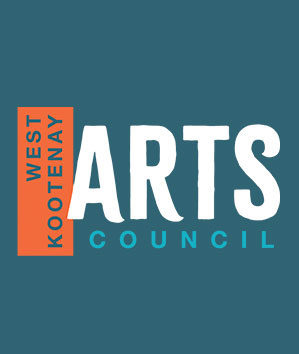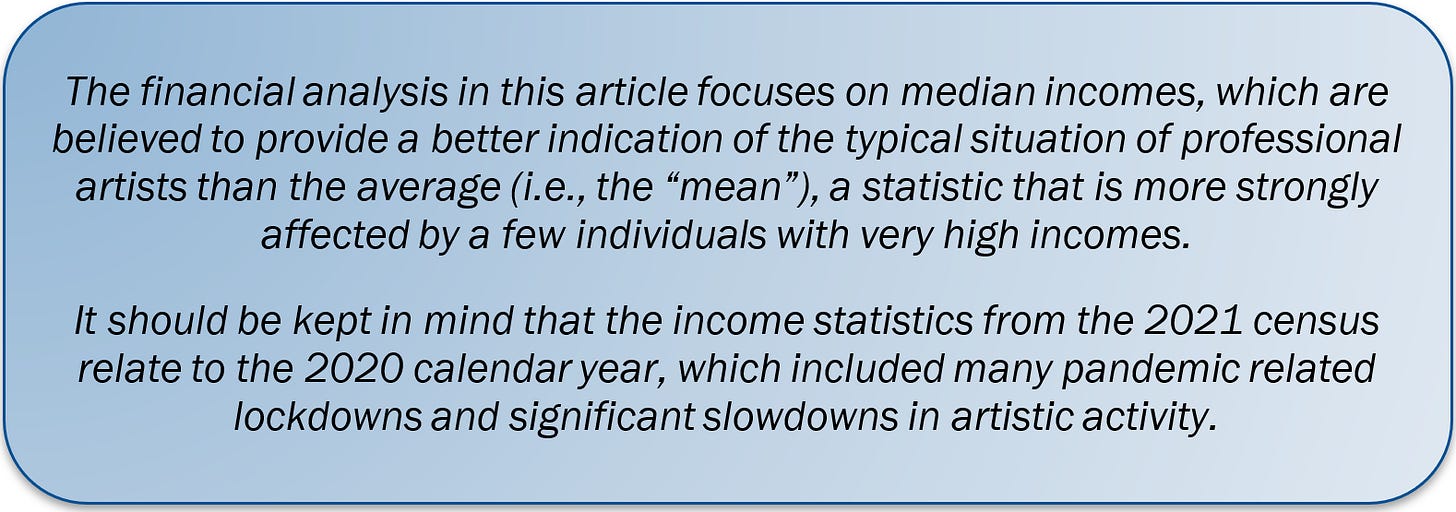Statistical profile of artists in B.C.’s Regional District of Kootenay Boundary
Kootenay Boundary has 120 professional artists, a large majority of whom are self-employed
Based on custom data that Hill Strategies requested from Statistics Canada’s 2021 long-form census, this article examines the demographics, employment characteristics, and incomes of artists who reside in the Regional District of Kootenay Boundary in British Columbia. Also included is brief information about workers in arts leadership occupations and all workers in the arts, culture, and heritage (a group that includes artists and arts leaders).
The article is made possible with the support of the West Kootenay Arts Council. An analysis of artists in neighbouring areas (the Columbia Basin, including the Regional District of Central Kootenay and the Regional District of East Kootenay) was prepared in 2023. Hill Strategies Research retained editorial control of the content.
Provincial and national context, plus key definitions
There are 39,700 professional artists who reside in B.C., representing 20% of the 202,900 artists in Canada. As a percentage of the overall labour force, artists account for 1.4% in B.C., the highest percentage among the provinces and well above the national average (1.0%). In B.C., one in every 72 workers is an artist, compared with one in every 102 Canadian workers. (Articles related to B.C. artists and Canadian artists are available. The Canadian post provides a list of the 10 artist occupation groups.)
56,200 Canadians, including 10,100 British Columbians, work in five occupation groups that are classified as arts leaders. B.C. accounts for 18% of Canada’s arts leaders, higher than the province’s share of all workers (14%). For more information on the occupation groups included as arts leaders, please see this Canada-wide article. Two of the arts leadership occupations (those including conductors and composers as well as producers, directors, and choreographers) are also included as artists. As such, the number of arts leadership workers should not be added to the number of artists in any jurisdiction.
The broadest analysis relates to the 154,800 British Columbians and 914,000 Canadians who work in arts, culture, and heritage occupations. These workers represent 5.4% of B.C.’s labour force, the highest proportion among the provinces and well above the national average of 4.4%. One in every 18 B.C. workers and every 23 Canadian workers has a cultural occupation.
The 52 occupation groups in this category include the 10 artist occupation groups as well as the 5 arts leadership occupation groups, other cultural occupations (e.g., graphic designers, print operators, editors, translators, architects, and professionals in fundraising, advertising, marketing, and public relations), and heritage occupations (e.g., librarians, curators, and archivists).
Further information about each of the categories is available, as are the methods behind choosing the 52 cultural occupation groups. Contextual information about the strengths and limitations of the census for counting artists and cultural workers is also available.
Census data relate to a very specific definition of professional workers: people who worked more hours as an artist than at any other occupation between May 1 and 8, 2021, plus people who were not in the labour force at that time but had worked more as an artist than at another occupation between January of 2020 and May of 2021. Part-time artists who spent more time at another occupation in May of 2021 would be classified in the other occupation. (The same would be true of workers in arts leadership occupations and all cultural occupations.)
The prevalence of “gig work” and the often-atypical nature of artists’ workflows can make it challenging for official statistics to count artists as artists. As such, census estimates of the number of artists might be low.
120 professional artists in Kootenay Boundary
There are 120 professional artists in the Regional District of Kootenay Boundary (hereafter “Kootenay Boundary”). Artists represent 1.0% of all workers in Kootenay Boundary, which is equal to the national average (1.0%) but below the provincial average (1.4%). Examined differently, these statistics mean that 1 in every 93 workers in Kootenay Boundary is a professional artist.
In comparison, there are 870 professional artists in the Columbia Basin, which is adjacent to Kootenay Boundary. The Columbia Basin total includes 570 artists in the Regional District of Central Kootenay and 250 in the Regional District of East Kootenay. In these jurisdictions, artists represent:
1.1% of the Columbia Basin’s overall labour force (equivalent to 1 in every 93 workers in the Columbia Basin)
1.7% of the overall labour force in Central Kootenay (1 in every 59 workers)
0.7% of the overall labour force in East Kootenay (1 in every 152 workers)
Demographic and employment characteristics of artists in Kootenay Boundary
Among the 120 artists in Kootenay Boundary:
83% are self-employed, many times higher than the self-employment rate of all workers in Kootenay Boundary (18%) and much higher than the rate among all B.C. artists (72%).
42% are women (potentially including some non-binary individuals), lower than the percentage of all workers in Kootenay Boundary (47%) and much lower than all B.C. artists (55%).
38% have a bachelor’s degree or higher, almost twice the proportion of all workers in Kootenay Boundary (20%) but similar to that of all B.C. artists (43%).
To ensure confidentiality and data reliability, no estimates of fewer than 40 people are presented in this article. There are fewer than 40 artists in many other demographic categories, and the data for them are not presented here. This includes the number of local artists who are Indigenous, members of a racialized group, immigrants to Canada, or in different age ranges.
Professional artists in Kootenay Boundary had very low median incomes in 2020
The following statistics and graph relate to median personal income, which includes all sources of income for individuals, such as employment income, net revenue from self-employment, pandemic supports, rental income, investment income, and others.
As shown in the graph, the median personal income of artists in Kootenay Boundary is $24,800, which is 48% less than the median of all local workers ($48,000).
In comparison, the median personal income of the roughly 40,000 professional artists in all of B.C. is $29,400, which is 40% less than the median of all workers in the province ($49,200).
Artists in Kootenay Boundary make significant financial sacrifices to practise their craft
This section provides two other measurements of the incomes of artists and all workers in Kootenay Boundary. Employment income shows the work-related earnings (including net self-employment income), and household income provides a measure of workers’ family situations.
These statistics indicate that Kootenay Boundary’s artists make significant financial sacrifices to practise their craft, especially in 2020, when the median employment income of artists was only $10,000, which is roughly one-quarter of the median in the local labour force ($38,400). This has an impact on artists' median personal income (48% lower than the overall labour force, as noted above) and on their total household income ($75,000, or 32% lower than the median of $110,000 in the local labour force).
No reliable data on the individual occupations of professional artists
As noted above, 40 people is the threshold of confidentiality and reliability for census counts. With 120 artists distributed among 10 occupation groups, the counts for each occupation group are not reliable for Kootenay Boundary.
50 arts leaders reside in Kootenay Boundary
Fifty Kootenay Boundary residents work in the five occupation groups that are classified as arts leaders. A breakdown by occupation is not possible, because there are fewer than 40 workers in each of the five occupation groups:
Library, archive, museum, and art gallery managers
Managers in publishing, motion pictures, broadcasting, and performing arts
Producers, directors, choreographers, and related occupations
Conductors, composers, and arrangers
Conservators and curators
In keeping with their senior positions, arts leaders in Canada tend to have relatively high incomes. However, this is not the case in Kootenay Boundary. In 2020, a typical arts leader in Kootenay Boundary had:
Employment income of just $14,300, 63% less than all Kootenay Boundary workers ($38,400)
Total personal income of $39,200, 18% less than all workers in Kootenay Boundary ($48,000)
Household income of $120,000, slightly higher (by 9%) than all local workers ($110,000)
Over 400 cultural workers in Kootenay Boundary
There are 430 workers in arts, culture, and heritage occupations in Kootenay Boundary, representing 2.6% of the 16,900 people in the local labour force, well below the provincial average (5.4%) and the national average (4.4%). One in every 39 workers in Kootenay Boundary has a cultural occupation.
In 2020, a typical cultural worker in Kootenay Boundary had:
Employment income of $17,600, 54% less than all Kootenay Boundary workers ($38,400)
Total personal income of $32,800, 32% less than all local workers ($48,000)
Household income of $105,000, slightly lower (by 5%) than all workers in Kootenay Boundary ($110,000)






